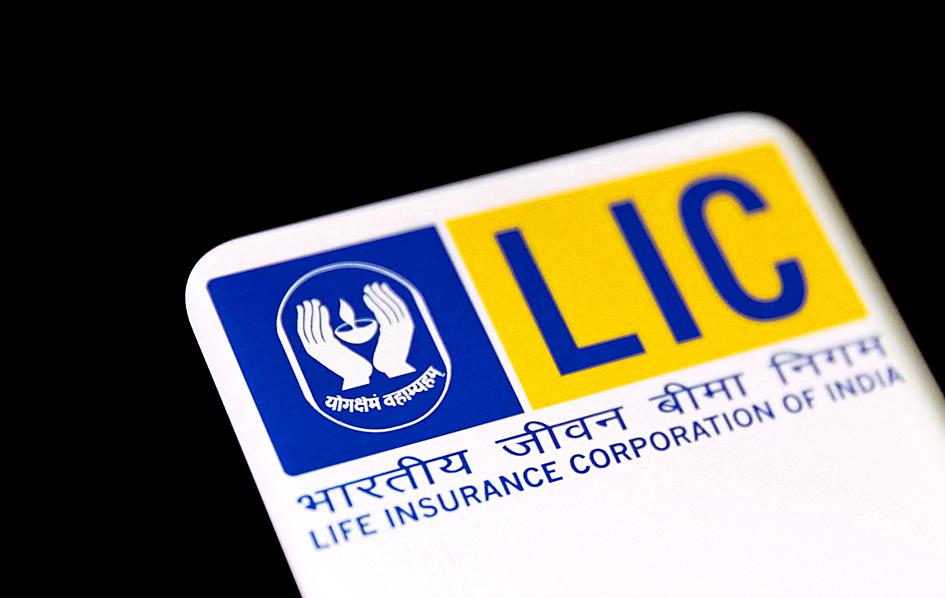Prospective investors in Life Insurance Corp of India’s (LIC) US$8 billion initial public offering (IPO) are seeking assurances from company management that it will not sacrifice their interests to meet goals set out by the Indian government, its controlling shareholder, sources said.
In virtual roadshows for India’s biggest ever public listing, LIC management and the IPO bankers have been peppered with questions about the insurer’s investments and their quality, four people with knowledge of the matter said.
LIC has in the past few years been a key buyer of shares in state-owned firms sold off by New Delhi, often bailing out less-than-successful public issues of shares. It has also been tapped to rescue struggling financial institutions.

Photo: Reuters
Potential conflicts of interest issues are taking center stage in the IPO roadshows, which began last week and are expected to go on till the end of the month, the sources said.
“The government tends to act as a regulator, manager and shareholder, and it tends to get its position confused at different points of time,” said Shriram Subramanian, founder of proxy advisory firm InGovern, who has not attended the roadshows.
“The government ministries may tend to think that LIC is 100 percent under their control and would like to exert that kind of an influence whenever required, and that is a concern for investors,” Subramanian said.
How effectively LIC and its investment bankers address the investor concerns will help in determining the insurer’s valuation in the float, and consequently the state of finances of the Indian government, which is banking on proceeds from the IPO to plug an annual fiscal deficit hole.
The Indian Ministry of Finance did not respond to e-mails seeking comment, while LIC declined to comment.
The sources declined to be identified as the discussions are private.
In its draft prospectus, the insurer cited involvement of the government — which owns 100 percent of LIC and is expected to own about 95 percent after the IPO — as a risk factor and said that minority shareholders could be disadvantaged by government action.
LIC chairman M.R. Kumar told a news conference on Monday that potential investors should not worry about government control after the IPO, as decisions are taken by its board and not by the government.
LIC, which was formed six decades ago when India’s insurance sector was nationalized, straddles the business in the country, with more than 280 million policies and more than 60 percent of the insurance segment.
It is also a big investor, owning as of March last year 23.5 trillion rupees (US$315 billion) of government securities, higher than even the Reserve Bank of India, out of the total central and state government securities worth 115.2 trillion rupees, the prospectus said.
In 2019, it took over IDBI Bank as the government struggled to find a viable buyer for the lender, whose shares had tanked and nearly one-third of its book had gone bad.
LIC said in its draft papers that it might have to infuse more capital into IDBI Bank even though it has been pursuing a buyer for its more than 50 percent stake in the lender.
Some market analysts and fund managers are drawing parallels between LIC and Coal India, which made its market debut in 2010 and, despite being a monopoly, has lost over half of its equity value.
In its most recent earnings call, Coal India chairman and managing director Pramod Agrawal said that one of the reasons for its current low market valuation could be because sometimes government takes steps that are not appreciated by shareholders.
“If LIC makes decisions that are not beneficial for the shareholders then they will raise concerns,” said Ashvin Parekh, an independent financial services consultant. “We have seen that happen earlier when Children Investment Fund exited from state-owned Coal India after listing, as it had concerns over what the majority shareholder was doing, and LIC could also face similar pushbacks from its shareholders.”

CHIP RACE: Three years of overbroad export controls drove foreign competitors to pursue their own AI chips, and ‘cost US taxpayers billions of dollars,’ Nvidia said China has figured out the US strategy for allowing it to buy Nvidia Corp’s H200s and is rejecting the artificial intelligence (AI) chip in favor of domestically developed semiconductors, White House AI adviser David Sacks said, citing news reports. US President Donald Trump on Monday said that he would allow shipments of Nvidia’s H200 chips to China, part of an administration effort backed by Sacks to challenge Chinese tech champions such as Huawei Technologies Co (華為) by bringing US competition to their home market. On Friday, Sacks signaled that he was uncertain about whether that approach would work. “They’re rejecting our chips,” Sacks

Taiwan’s long-term economic competitiveness will hinge not only on national champions like Taiwan Semiconductor Manufacturing Co. (TSMC, 台積電) but also on the widespread adoption of artificial intelligence (AI) and other emerging technologies, a US-based scholar has said. At a lecture in Taipei on Tuesday, Jeffrey Ding, assistant professor of political science at the George Washington University and author of "Technology and the Rise of Great Powers," argued that historical experience shows that general-purpose technologies (GPTs) — such as electricity, computers and now AI — shape long-term economic advantages through their diffusion across the broader economy. "What really matters is not who pioneers

TAIWAN VALUE CHAIN: Foxtron is to fully own Luxgen following the transaction and it plans to launch a new electric model, the Foxtron Bria, in Taiwan next year Yulon Motor Co (裕隆汽車) yesterday said that its board of directors approved the disposal of its electric vehicle (EV) unit, Luxgen Motor Co (納智捷汽車), to Foxtron Vehicle Technologies Co (鴻華先進) for NT$787.6 million (US$24.98 million). Foxtron, a half-half joint venture between Yulon affiliate Hua-Chuang Automobile Information Technical Center Co (華創車電) and Hon Hai Precision Industry Co (鴻海精密), expects to wrap up the deal in the first quarter of next year. Foxtron would fully own Luxgen following the transaction, including five car distributing companies, outlets and all employees. The deal is subject to the approval of the Fair Trade Commission, Foxtron said. “Foxtron will be

BUBBLE? Only a handful of companies are seeing rapid revenue growth and higher valuations, and it is not enough to call the AI trend a transformation, an analyst said Artificial intelligence (AI) is entering a more challenging phase next year as companies move beyond experimentation and begin demanding clear financial returns from a technology that has delivered big gains to only a small group of early adopters, PricewaterhouseCoopers (PwC) Taiwan said yesterday. Most organizations have been able to justify AI investments through cost recovery or modest efficiency gains, but few have achieved meaningful revenue growth or long-term competitive advantage, the consultancy said in its 2026 AI Business Predictions report. This growing performance gap is forcing executives to reconsider how AI is deployed across their organizations, it said. “Many companies